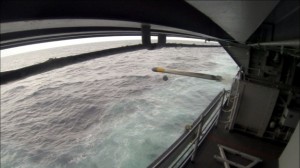 Look what’s back! The tiny torpedo! After a long gestation period, the old and much-maligned World War II-era Cutie torpedo is getting to sea, fresh and reinvented for a different decade…And that’s great!
Look what’s back! The tiny torpedo! After a long gestation period, the old and much-maligned World War II-era Cutie torpedo is getting to sea, fresh and reinvented for a different decade…And that’s great!
Even though the “Countermeasure Anti-Torpedo (CAT)” (or, as I call it the CUTIE II) is being placed on big surface ships as a self-defense measure, there is no reason to constrain the CAT’s mission to anti-torpedo work. For any tough-to-resupply platform challenged by large numbers of small, low-value targets, there’s much to love in having a handful of cheap, small, (hopefully) simple-tech homing torpedoes smaller than Mk 50/Mk 54 variants (Earlier in development, CAT’s forebear, the Anti-Torpedo Torpedo, reportedly had a 6.75 inch diameter seaframe of about 200 lbs.).
The CAT will obviously never endanger the grand-daddy MK ADCAP heavyweight torpedo. These big 3,500+ pound underwater rockets and their 650 pounds of high-explosives offer an immediate, tough-to-defeat kill.
But a tiny torpedo to disable small patrol craft or UUVs is overdue.
It’s been a long road for tiny torpedoes. The first “mini-torpedoes” were not entirely popular–as you might guess from this summary of the first use of the Cutie in wartime, from Clay Blair’s great book, Silent Victory: The U.S. Submarine War Against Japan:
“When Bennett [skipper of the USS Sea Owl (SS-405)] returned from patrol, Lockwood was pleased. Although the test had been “spotty” (as Lockwood described it), it seemed to him that the Cutie had merit, especially as a weapon to use against shallow-draft antisubmarine vessels. Even if the Cutie didn’t sink them, it might damage the propellers and force them to stop, as had been the case in Bennett’s first two attacks. Then, once they had been stopped, a submarine might actually sink them with another Cute or with an electric set to run at shallow depths from short range…”
But heavyweight torpedoes, as much as they offer, are just too big for many of the numerous low-value targets out there today. And as UUVs (and subs) get smaller and smaller (and the imperative to quickly get rid of unmanned pests grows and grows), small, simpler torpedoes are the only viable option.
(This isn’t just a Navy problem. The Coast Guard has a responsibility to consider this type of weapon as well. If the Coast Guard is tasked to stop an incoming freighter, outside of a hostile takeover of the ship, the Coasties have little in the way of options. I’d love to see a Medium Endurance Cutter try to stop even a smallish oil-tanker by guns alone. A small torpedo, capable of disrupting propulsion and/or steering mechanisms, can stop a large ship in its tracks.)
Of course, the ultimate customer for a tiny tactical torpedo will be the Unmanned Vehicle Community itself, which is, I assume, always eager to hear about anything that might match the same general dimensions as, say, the average Hellfire missile

{ 1 trackback }
{ 2 comments… read them below or add one }
Always a pleasure to hear from the best Coast Guard Blogger out there (and he’s California-based, no less!)…Shoot me an email with your current contact info, will ya?
Craig, Nice to see you back on the Web. You picked up on one of my favorite topics.